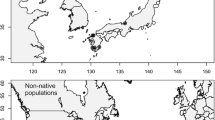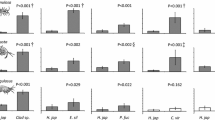Summary
A. fluviatilis is a herbivore which usually ingests periphyton. Evidence derived from both field observation and laboratory experiments suggests that the limpet prefers diatoms and that within this group Gomphonema is apparently the most attractive genus. These food preferences were most clearly defined in satiated individuals.
Snails had no apparent effect on algal community structures in the field situation and it is suggested that this may either result from adaptability of the periphyton with respect to grazing disturbances, or from low snail density and thus low grazing intensity.
The food preferences of A. fluviatilis in particular, and other algal exploiters in general, are discussed in terms of plant defense mechanisms. It is argued that an animal's ability to cope with algal cell walls (either in a mechanical or chemical sense) may be one of the major determinants in the food preference behaviour shown by herbivores feeding on algae.
Similar content being viewed by others
References
Ahmad, M. R.: Observations on the effect of feeding Labio rohita (Ham.) with Microcystis aeruginosa (Kutz.). Hydrobiologia 29, 388–392 (1967).
Allen, E., Nelson, E. W.: On the artificial culture of marine plankton organisms. J. mar. biol. Ass. U.K. 8, 421–474 (1910).
Bold, H. C.: The cultivation of algae. Bot. Rev. 8, 69–138 (1942).
Bovbjerg, R. V.: Feeding and dispersal in the snail Stagnicola reflexa (Basommatophora: Lymnaeidae). Malacologia 2, 199–207 (1965).
Bovbjerg, R. V.: Responses to food in Lymnaeid snails. Physiol. Zool. 41, 412–423 (1968).
Boycott, A. E.: The habitats of freshwater Mollusca in Britain. J. Anim. Ecol. 5, 116–186 (1936).
Brook, A. J.: The bottom-living algae of slow sand filter-beds of waterworks. Hydrobiologia 6, 333–351 (1954).
Brook, A. J.: The attached algal flora of slow sand filter-beds of waterworks. Hydrobiologia 7, 103–107 (1955a).
Brook, A. J.: The aquatic fauna as an ecological factor in studies of the occurrence of freshwater algae. Rev. algol. n.s. 1, 142–145 (1955b).
Brown, D. S.: Ingestion and digestion of algae by Chloeon dipterum (Ephemeroptera). Hydrobiologia 16, 81–96 (1960).
Calow, P.: Studies on the natural diet of Lymnaea pereger obtusa (Kobelt) and its possible ecological implications. Proc. malac. Soc. Lond. 39, 203–215 (1970).
Calow, P.: A method for determining the surface areas of stones to enable quantitative density estimates of littoral stonedwelling organisms to be made. Hydrobiologia 40, 37–50 (1972a).
Calow, P.: The structural and functional dynamics of selected species-populations of freshwater snails: towards a systems approach. Unpublished Ph. D. thesis, University of Leeds (1972b).
Calow, P.: Field observations and laboratory experiments on the general food requirements of two species of freshwater snail Planorbis contortus (Linn.) and Ancylus fluviatilis (Müll.). Proc. malac. Soc. Lond. (in press, 1973).
Douglas, B.: The ecology of attached diatoms and other algae in a small stony stream. J. Ecol. 46, 295–322 (1958).
Ehrlich, P. R., Birch, L. C.: The “balance of nature”, and “population control”. Amer. Nat. 101, 97–107 (1967).
Emlen, J. M.: The role of time and energy in food preference. Amer. Nat. 100, 611–617 (1966).
Favier-Gamulin, D.: Influence de l'alimentation sur le cycle vital de Gundlachia wauteri (Mollusque: Bassomatophore). Extrait du Bulletin Mensuel de la Societé Lineene de Lyon, No 10, 350–358 (1969).
Feeny, P.: Seasonal changes in oak leaf tannins and nutrients as a cause of spring feeding by Winter moth caterpillars. Ecology 51, 565–581 (1970).
Findenegg, I.: Expression of populations. A manual on methods for measuring primary production in aquatic environments. I.B.P. Handbook No. 12, R. A. Vollenweider, Ed., p. 5–7. Oxford: Blackwells 1969.
Fish, G. R.: Digestion in Tilapia esculenta. Nature (Lond.) 167, 900 (1950).
Fryer, G.: The food of some freshwater cyclopoid copepods and its ecological significance. J. Anim. Ecol. 26, 263–286 (1957).
George, M. G.: Occurrence of a permanent algal bloom in a fish tank at Delhi, with special reference to factors responsible for its production. Proc. Indian Acad. Sci. 56 B, 354–362 (1962).
Grime, J. P., Blythe, G. M., Thornton, T. D.: Food selection by the snail Cepaea nemoralis L. Animal populations in relation to their food resources. British Ecological Society Symposium No. 10, A. Watson, Ed., p. 73–99. Oxford-Edinburgh: Blackwells 1970.
Hairston, N. G., Smith, F. E., Slobodkin, L. B.: Community structure, population control, and competition. Amer. Nat. 94, 421–425 (1960).
Hargrave, B. T.: The utilisation of benthic microflora by Hyalella azteca (Amphipoda). J. Anim. Ecol. 39, 427–437 (1970).
Hargrave, B. T., Green, G. H.: Effects of copepod grazing on two natural phytoplankton populations. J. Fish. Res. Bd. Can. 27, 1395–1403 (1970).
Harvey, H. W.: The chemistry and fertility of sea waters. Cambridge: University Press 1955.
Hazel, D. B.: The effect of grazing intensity on plant composition, vigor, and production. J. Range Mange 20, 249–252 (1967).
Ingram, W. M., Presscott, G. W.: Toxic freshwater algae. Amer. Midl. Nat. 52, 75–87 (1954).
Ivlev, V. S.: Experimental ecology of the feeding of fishes. New Haven: Yale University Press 1961.
Kehde, P. M., Wilhm, J. L.: The effects of grazing by snails on community structure of periphyton in laboratory streams. Amer. Midl. Nat. 87, 8–24 (1972).
Krishnamoorthi, K. P.: A review of some aspects of fish mortality. Bull. CPHERI, Nagpur (India) 3, 1–6 (1961).
Lewin, R. A.: The isolation of algae. Revue algol. 15, 181–197 (1959).
Mason, C. F.: Food, feeding rates and assimilation in woodland snails. Oecologia 4, 358–373 (1970).
Murdoch, W. W.: Community structure, population control and competition. Amer. Nat. 100, 219–226 (1966).
Nauwerk, A.: Die Beziehungen zwischen Zooplankton im See Erken. Symb. Bot. Upsal. 17, 1–163 (1963).
Pallant, D.: The food of the grey slug (Agriolimax reticulatus) in woodland. J. Anim. Ecol. 38, 391–397 (1969).
Patrick, R.: Benthic stream communities. Amer. Scient. 59, 546–549 (1970).
Pennington, W.: The control of the numbers of freshwater phytoplankton by small invertebrate animals. J. Ecol. 29, 204–212 (1941).
Presscott, G. W.: Objectionable algae with reference to the killing of fish and other animals. Hydrobiologia 1, 1–13 (1948).
Presscott, G. W.: The algae: A review. London: Thos. Nelson 1969.
Saraceni, C., Ruggui, D.: Sampling techniques and methods for estimating quantity and quality of biomass (Phytoplankton). A manual on methods for measuring primary production in aquatic enviroments. I.B.P. Handbook No. 12, R. A. Vollenweider, Ed., p. 5–7. Oxford: Blackwells 1969.
Starr, R. C.: The culture collection of algae at Indiana University. Amer. J. Bot. 51, 1013–1044 (1964).
Taylor, J. W.: A monograph of the land and freshwater mollusca of the British Isles. Leeds: Taylor Bros. 1895.
Tomanek, G. W., Albertson, F. W.: Some effects of different intensities of grazing on mixed prairies near Hays, Kansas. J. Range Manage. 6, 299–306 (1953).
Velasquez, G. F.: On the viability of algae obtained from the digestive tract of the gizzard shad Dorosoma cepedianum (le Sueur). Amer. Midl. Nat. 22, 376–412 (1939).
Vetter, H.: Limnologische Untersuchungen des Phytoplankton, seine Beziehungen zur Ernährung des Zooplanktons im Schleinsee bei Langenargen am Bodensee. Int. Rev. Hydrobiol. 34, 499–561 (1937a).
Vetter, H.: Bemerkungen über das Phytoplankton und seine Beziehungen zur Ernährung des Crustaceenplanktons im Schussenhaltwasser und im Bühelweiher. Schr. Ver. Gesch. Bodensees 64, 3–15 (1937b).
Walne, P. R.: Studies on the food value of nineteen genera of algae to juvenile bivalves of the genera Ostrea, Crassostrea, Mercenaria and Mytilus. Fishery Invest. London 26, 1–62 (1970).
Wolda, H., Zweep, A., Schuitema, K. A.: The role of food in the dynamics of populations of the land snail Cepaea nemoralis. Oecologia 7, 361–381 (1971).
Author information
Authors and Affiliations
Rights and permissions
About this article
Cite this article
Calow, P. The food of Ancylus fluviatilis (Müll.), a littoral stone-dwelling, herbivore. Oecologia 13, 113–133 (1973). https://doi.org/10.1007/BF00345644
Received:
Issue Date:
DOI: https://doi.org/10.1007/BF00345644




